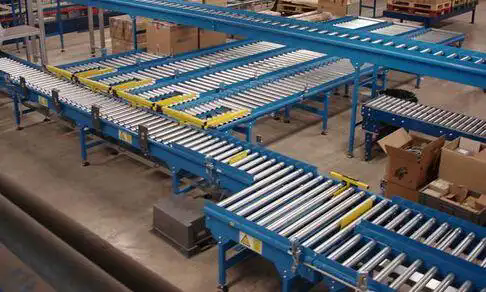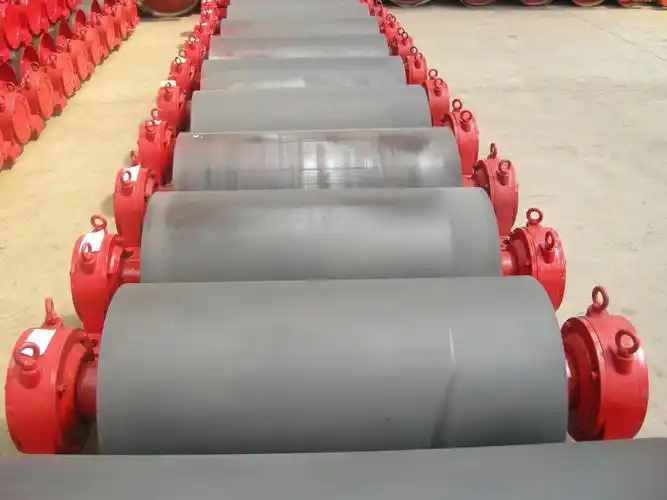Belt Driven Live Roller conveyors are a type of powered roller conveyor where the rollers are driven by a continuous belt underneath them. This system is widely used in various industries for moving products in a controlled and efficient manner. The primary advantage of a BDLR conveyor is its ability to transport goods smoothly across long distances and inclines while offering flexibility in design and integration.
BDLR conveyors are commonly found in industries such as logistics, manufacturing, packaging, and distribution. They are suitable for handling a wide range of products, from packaged goods to heavy and bulky items, thanks to their robust construction and adjustable settings.
In this guide, we will cover various aspects of BDLR conveyors, including installation, applications, maintenance, troubleshooting, and repair. We will also provide practical tips and considerations to ensure optimal performance throughout the system’s lifecycle.

1. Components and Working Principle of BDLR Conveyors
Before diving into installation, maintenance, and troubleshooting, it's important to understand how BDLR conveyors function.
Main Components:
| Komponente | Beschreibung |
|---|---|
| Rollen | Cylindrical components that transfer power from the belt to move items. The rollers are usually made of steel or plastic. |
| Drive Belt | The continuous belt that transmits power to the rollers. The belt is typically made from rubber or PVC material. |
| Motor | Provides the driving force to the belt, typically connected to a gear motor. |
| Rahmen | The structure that holds the rollers, drive motor, and other components. It is usually made from steel or aluminum. |
| Umlenkrollen | These are non-powered rollers placed along the conveyor to support the load and assist in product movement. |
| Controller | Electronic devices or systems used to control the motor’s speed, direction, and sometimes the power distribution. |
Working Principle:
BDLR conveyors operate by using a motor to drive a continuous belt, which in turn moves the rollers that are placed along the conveyor. The product is then transported via friction between the rollers and the load, creating a controlled flow of goods. The motion of the rollers can be adjusted by varying the motor's speed, depending on the desired throughput.
2. Applications of BDLR Conveyors
BDLR conveyors are versatile and can be used in a wide array of applications. Below are some of the most common uses:
| Industry | Anwendungen | Products Handled |
|---|---|---|
| Verpackung | Transporting packaged goods, cartons, and cases | Boxes, crates, bags |
| Automobilindustrie | Moving vehicle parts between stations | Car parts, engines |
| Food & Beverage | Conveying food items along production lines | Bottles, cans, packaged foods |
| Logistics & Warehousing | Sorting and distributing packages | Boxes, mail, parcels |
| Herstellung | Moving components between production areas | Metal parts, components |
3. Installation of a BDLR Conveyor
Proper installation is crucial for ensuring the smooth and efficient operation of a BDLR conveyor system. The process typically involves several steps, including preparing the site, assembling components, and adjusting the system.
Installation Steps:
- Site Preparation: Ensure that the area where the conveyor will be installed is clean, flat, and free from obstructions. Measure the area to confirm that the conveyor will fit properly.
- Frame Assembly: Begin by assembling the frame, making sure it is level and properly aligned. Use adjustable feet if necessary to ensure stability.
- Roller and Belt Placement: Position the rollers along the frame and connect the drive belt. The drive motor should be installed at one end of the conveyor, and the belt should be connected to the motor’s pulley system.
- Motor Setup: Install the motor and connect it to the power supply. Depending on the system design, this might involve hardwiring or using a plug-and-play electrical connection.
- Spannung anpassen: After the belt is in place, adjust the tension to ensure the belt moves smoothly without slipping or stretching excessively.
- Test Run: Once the conveyor is assembled, run a test to check for any issues such as misalignment, excessive noise, or uneven motion. Make adjustments as necessary.
4. Maintenance and Care of BDLR Conveyors
To ensure longevity and smooth operation, regular maintenance is key. Proper maintenance minimizes downtime, extends the lifespan of the system, and improves overall efficiency.
Routinemäßige Wartungsaufgaben:
| Aufgabe | Frequenz | Tipps |
|---|---|---|
| Check Belt Tension | Monatlich | Proper belt tension ensures smooth operation. Adjust if loose or tight. |
| Inspect Rollers | Bi-weekly | Check for signs of wear, rust, or damage. Replace any faulty rollers. |
| Lubricate Motor and Bearings | Vierteljährlich | Use appropriate lubricants to avoid overheating and friction. |
| Clean the Conveyor | Wöchentlich | Remove debris, dust, or spilled products from the belt and rollers. |
| Ausrichtung prüfen | Monatlich | Ensure that rollers are aligned to prevent uneven wear on the belt. |
Common Maintenance Issues:
- Belt Slippage: Often caused by poor tension or excessive load. Re-adjust the tension or remove excess load.
- Noisy Operation: Typically due to dirt or damaged rollers. Clean or replace as necessary.
- Overheating Motor: Ensure the motor is not overloaded, and check the electrical connections for any faults.
5. Troubleshooting BDLR Conveyor Problems
Even with regular maintenance, problems can occur. Here are some common issues and troubleshooting steps to address them:
1. Belt Slipping or Stalling
- Ursache: Insufficient tension or contamination on the belt.
- Lösung: Check and adjust belt tension. Clean the belt to remove any debris that may be causing slippage.
2. Uneven Product Movement
- Ursache: Misaligned rollers or inconsistent tension.
- Lösung: Re-align the rollers and adjust belt tension. Inspect for any obstruction on the rollers.
3. Excessive Noise
- Ursache: Worn-out rollers or bearings.
- Lösung: Lubricate or replace damaged components. Ensure that rollers are running freely.
4. Motor Failure
- Ursache: Electrical issues, overload, or motor wear.
- Lösung: Check electrical connections and ensure the motor is properly wired. If the motor is overloaded, reduce the load on the conveyor.
6. Repairing BDLR Conveyors
When a part of the conveyor system fails, it is important to address the issue promptly to avoid downtime. Some common repair scenarios include:
1. Replacing the Drive Belt
Over time, the drive belt may wear out and require replacement. Here’s how to replace it:
- Remove the old belt by disconnecting it from the drive motor and pulleys.
- Place the new belt on the pulleys and rollers, ensuring proper alignment.
- Adjust the tension to ensure smooth operation.
2. Replacing Worn Rollers
Worn rollers can cause friction issues and slow down the conveyor. Here’s how to replace them:
- Remove the damaged rollers from the frame.
- Slide the new roller into place and secure it using fasteners.
- Test the new roller to ensure it moves smoothly.
3. Motor Replacement
If the motor fails, it may need to be replaced:
- Disconnect the motor from the electrical supply.
- Remove the motor from the frame.
- Install the new motor, ensuring it is correctly aligned with the pulley system.
- Reconnect the electrical supply and test the motor’s operation.
7. Abschluss
Belt Driven Live Rollenförderer (BDLR) are a vital component in many industrial and commercial operations, offering efficiency and versatility. By understanding the basic principles of operation, installation, maintenance, and troubleshooting, operators can ensure optimal performance and longevity of their conveyor systems.
Regular maintenance, timely repairs, and proper troubleshooting can prevent costly downtime and extend the lifespan of the equipment. With the right care and attention, BDLR conveyors can continue to provide reliable service for many years, contributing to increased productivity and efficiency in the workplace.


